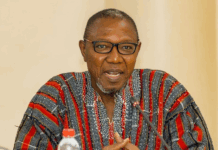
The International Monetary Fund (IMF) Executive Board on 13th April, 2020 approved the disbursement of US$ 1 billion to be drawn under the Rapid Credit Facility (RCF). The disbursement will help address the urgent fiscal and balance of payments needs that Ghana is facing, improve confidence and catalyze support from other development partners. The RCF is available to low income countries and it carries a zero interest rate. RCF has a grace period of 5½ years and a final maturity of 10. Countries like Mozambique, Liberia and Guinea accessed this facility in the wake of Cyclone Idai and Ebola. The table below shows some macroeconomic indicators.
Economic Indicators
| INDICATOR | 2018 (Est) | 2019 (Prel) | 2020 (Proj) |
| GDP at Constant Prices (%) | 6.8 | 6.1 | 1.5 |
| GDP per Capita (US$) | 2,217 | 2,229 | 2,085 |
| Inflation (CPI)-Annual Average (%) | 9.8 | 7.2 | 9.7 |
| Fiscal Deficit (excluding financial and energy sector related cost) | -3.7 | -4.7 | -6.4 |
| Primary Balance (%) | -1.4 | -1.8 | -4.1 |
| Public Debt | 59.0 | 63.2 | 68.7 |
| Net Int. Reserves (Import Cover) | 1.9 | 2.7 | 2.1 |
Source: IMF Press Release No. 20/153
Aftermath of Extended Credit Facility Program
On 3rd April, 2015, the Executive Board of the IMF approved a three-year arrangement under the Extended Credit Facility (ECF) for Ghana in an amount equivalent to SDR 664.20 million (180 percent of quota or about US$918 million) in support of the authorities’ medium-term economic reform programme. The program was extended for another year because of missed targets in the initial years of implementation. The main pillars of the program were;
- To achieve sizeable and frontloaded fiscal adjustment, to restore debt sustainability, to contain expenditures through wage restraint and limited net hiring, as well as on measures to mobilise additional revenues.
- To embark on structural reforms to strengthen public finances and fiscal discipline by improving budget transparency, cleaning-up and controlling the payroll, right-sizing the civil service and improving revenue collection.
- To restore the effectiveness of the inflation targeting framework to help bring inflation back into single digit territory and preserve financial sector stability.
- To safeguard social and other priority spending under the program, including expanding the targeted social safety nets—such as the Livelihood Empowerment Against Poverty (LEAP) program.
The successful implementation of the ECF program resulted in improved macroeconomic indicators. GDP growth picked up from 3.4% in 2016 to 8.1 percent in 2017 and declined to 6.1% 2019. Inflation declined from 15.4% to 9.0% in January 2019 and further declined to 7.9% by the end of 2019. Fiscal deficit also declined from 7.3% of GDP in 2016 to 3.8% in 2018 and 4.7% (excluding financial and energy sector related costs) in 2019. The primary balance turned positive at the end of 2017; the first time in almost a decade.
Significant pieces of legislations were enacted during and after the Fund program. This includes the passage of Special Deposit Taking Act 2016 (Act 930) and the amendment of the Bank of Ghana Act 2016 (Act 918) to ensure financial sector stability in Ghana’s economy. A key clause of the Bank of Ghana Amendment Act was the BoG financing of central government. The Fund proposed a zero financing of central government by the BoG but Parliament rejected that provision and instead pegged it at five percent of previous year’s revenue.
More so, Parliament in August 2016 passed the Public Financial Management (PFM) Act 2016, Act 921, which repealed the Financial Administration Act of 2003 and its amendment and the Loans Act of 1970. The PFM seeks to regulate the financial management of the public sector within a macroeconomic and fiscal framework, as well as define the responsibilities of persons entrusted with the management and control of public funds, assets, liabilities and other resources. It also seeks to ensure that public funds are sustainable and consistent with the level of public debt and also makes provision for accounting and audit of public funds. The fiscal and monetary stability councils were also established. The Fiscal Responsibility Act, 2018 (982) establishes two numerical fiscal rules, limiting the overall fiscal deficit on a cash basis to 5% of GDP and mandating a positive primary balance.
The 2015 ECF program had conditionalities attached to its implementation which includes austerity measures such as tax hikes, reduced spending and net hiring freeze. Ghana also went through eight (8) reviews before the completion of the program and disbursements of the US$ 918 million was done in tranches subject to performance reviews. On the other hand, the RCF has limited conditionalities. IMF’s support under RCF is provided without ex post program-based conditionality or reviews. Economic policies supported under RCF aims at addressing the underlying balance of payments difficulties and support the country’s poverty reduction and growth objectives. Repeat use of the RCF may facilitate eventual transition to an ECF arrangement. It is premature to call for a repeated use of RCF which could result in an ECF program. Government’s position on ECF is known; it offers a tight fiscal space which is parallel to the expansionary policies formulated.
A Reversal of Gains?
On 30th March, 2020, the Finance Minister presented an Economic Impact of the Covid-19 Pandemic on the Economy of Ghana to Parliament. As part of measures under the Coronavirus Alleviation Programme, the minister proposed;
- Amendment of the Bank of Ghana Act to allow for government borrowing from BOG beyond the stimulated threshold in the Act in the event of tight domestic financing market conditions.
- Amend the Petroleum Revenue Management Act (PRMA) to allow a withdrawal from the Ghana Heritage Fund to undertake urgent expenditures in relation to the Coronavirus pandemic. There is an estimated US$591.1 millionin the Ghana Heritage Fund.
These are early days to compare the current state of Ghana’s economy to that of 2014, 2015 but there are some economic indicators that are not performing well which includes depreciating exchange rate, ballooning public debt and severe commodity price shocks partly as a result of Covid-19 pandemic. This year is an election year and the data points to fiscal slippages that characterizes such years. It is safe to assume that, 2020 will not be an exception partly because of this pandemic but managers of the economy should have medium term macroeconomic stability in mind when making these short term decisions as aforementioned. Budget deficit and its associated public debt is not bad in itself but it depends on investment options (recurrent and capital expenditure). There should be utmost transparency and accountability in management of public funds during this crisis to prevent adverse macroeconomic instability in the medium to long term. These are not normal times and hence government should rationalize expenditure as much as possible to limit impact of the pandemic on the economy.
Emmanuel Amoah-Darkwah
Economic Analyst
e.amoahdarkwah@gmail.com
























